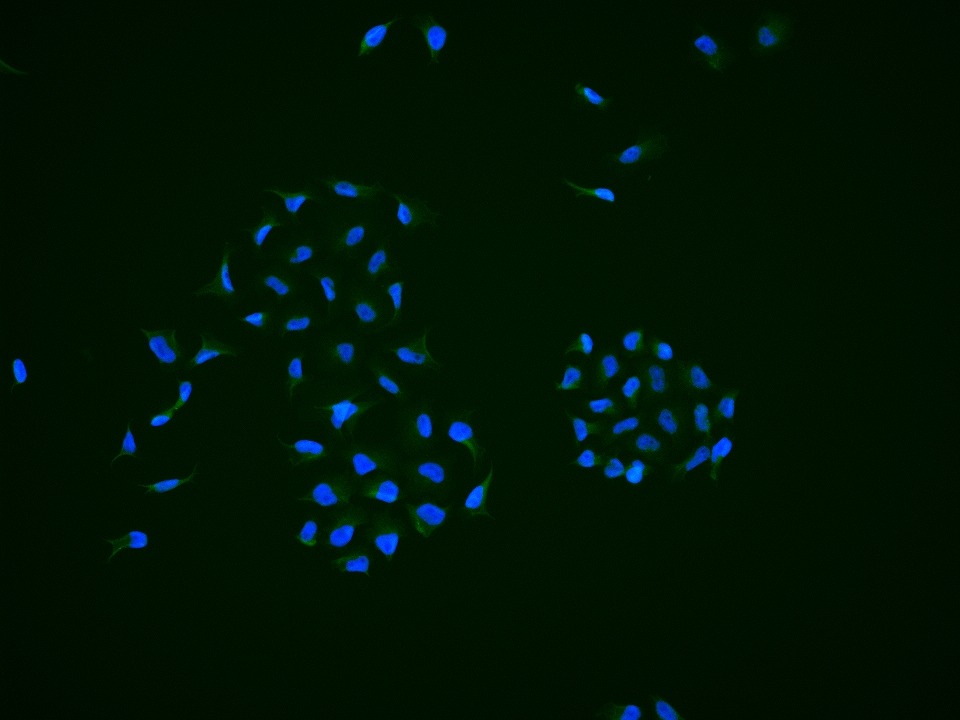Shopping Cart
Remove All Your shopping cart is currently empty
Your shopping cart is currently empty
Anti-LATS1 Polyclonal Antibody is a Rabbit antibody targeting LATS1. Anti-LATS1 Polyclonal Antibody can be used in ICC/IF.
| Pack Size | Price | USA Warehouse | Global Warehouse | Quantity |
|---|---|---|---|---|
| 50 μL | $221 | 7-10 days | 7-10 days | |
| 100 μL | $373 | 7-10 days | 7-10 days | |
| 200 μL | $529 | 7-10 days | 7-10 days |
| Description | Anti-LATS1 Polyclonal Antibody is a Rabbit antibody targeting LATS1. Anti-LATS1 Polyclonal Antibody can be used in ICC/IF. |
| Synonyms | WARTS protein kinase (h-warts), WARTS, Serine/threonine-protein kinase LATS1, LATS1, Large tumor suppressor homolog 1 |
| Ig Type | IgG |
| Reactivity | Human (predicted:Mouse,Rat,Chicken,Pig,Cow,Horse,Rabbit) |
| Verified Activity | Hela cell; 4% Paraformaldehyde-fixed; Triton X-100 at room temperature for 20 min; Blocking buffer (normal goat serum) at 37°C for 20 min; Antibody incubation with (LATS1) polyclonal Antibody, Unconjugated (TMAB-01050) 1:25, 90 minutes at 37°C; followed by a conjugated Goat Anti-Rabbit IgG antibody at 37°C for 90 minutes, DAPI (blue) was used to stain the cell nucleus.  |
| Application | |
| Recommended Dose | ICC/IF: 1:25 |
| Antibody Type | Polyclonal |
| Host Species | Rabbit |
| Subcellular Localization | Cytoplasm, cytoskeleton, centrosome. Cytoplasm. Cytoplasm, cytoskeleton, spindle pole. |
| Tissue Specificity | Expressed at high levels in heart and skeletal muscle and at lower levels in all other tissues examined. |
| Construction | Polyclonal Antibody |
| Purification | Protein A purified |
| Appearance | Liquid |
| Formulation | 0.01M TBS (pH7.4) with 1% BSA, 0.02% Proclin300 and 50% Glycerol. |
| Concentration | 1 mg/mL |
| Research Background | This gene encodes a serine/threonine protein kinase belonging to the LATS tumor suppressor family. The protein localizes to centrosomes during interphase, and early and late metaphase. It interacts with the centrosomal proteins aurora-A and ajuba and is required for accumulation of gamma-tubulin and spindle formation at the onset of mitosis. It also interacts with a negative regulator of p53 and may function in a positive feedback loop with p53 that responds to cytoskeleton damage. Additionally, it can function as a co-repressor of androgen-responsive gene expression. [provided by RefSeq]. |
| Immunogen | KLH conjugated synthetic peptide: human LATS1 |
| Antigen Species | Human |
| Gene Name | LATS1 |
| Gene ID | |
| Protein Name | Serine/threonine-protein kinase LATS1 |
| Uniprot ID | |
| Biology Area | Tumor suppressors,Kinases,Cytokinesis,Cdk Regulators |
| Function | Negative regulator of YAP1 in the Hippo signaling pathway that plays a pivotal role in organ size control and tumor suppression by restricting proliferation and promoting apoptosis. The core of this pathway is composed of a kinase cascade wherein STK3/MST2 and STK4/MST1, in complex with its regulatory protein SAV1, phosphorylates and activates LATS1/2 in complex with its regulatory protein MOB1, which in turn phosphorylates and inactivates YAP1 oncoprotein and WWTR1/TAZ. Phosphorylation of YAP1 by LATS2 inhibits its translocation into the nucleus to regulate cellular genes important for cell proliferation, cell death, and cell migration. Acts as a tumor suppressor which plays a critical role in centrosome duplication, maintenance of mitotic fidelity and genomic stability. Negatively regulates G1/S transition by down-regulating cyclin E/CDK2 kinase activity. Negative regulator of the androgen receptor. |
| Molecular Weight | Theoretical: 124 kDa. |
| Stability & Storage | Store at -20°C or -80°C for 12 months. Avoid repeated freeze-thaw cycles. |
| Transport | Shipping with blue ice. |
| Size | Quantity | Unit Price | Amount | Operation |
|---|

Copyright © 2015-2025 TargetMol Chemicals Inc. All Rights Reserved.